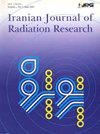Dose distributions of high-precision radiotherapy treatment: A comparison between the CyberKnife and TrueBeam systems
Q4 Health Professions
引用次数: 5
Abstract
Background: Several high-precision stereotactic radiation therapy modalities are currently used in clinical settings. We aimed to evaluate whether the CyberKnife (CK) or TrueBeam (TB) radiation treatment systems were more appropriate for treating targets of various morphologies according to the physical properties of each device. Materials and Methods: Spheres (diameter = 5–50 mm), as well as triangular prisms and cubes (length of a side = 10–50 mm), were used as virtual targets for each treatment delivery system. A phantom with dosimetry film was irradiated to evaluate the flatness and gradient of the radiation treatment from each modality. Results: The homogeneity index (HI) for the spherical targets was significantly higher (dose distribution was more homogeneous) using the TB than when using the CK (1.9 vs. 1.4; p = 0.002). There were no significant differences between treatment modalities in the HI for more complex shapes. The HI increased monotonically as the virtual target diameter increased for the CK (p = 0.048). The flatness parameter was lower for the TB than for the CK (1.4 vs. 1.1; p < 0.001). Conclusion: The CK is particularly robust for delivering therapeutic radiation to small targets, while the TB is more suitable for targets with a simple shape or when the HI is a critical treatment factor.高精度放射治疗的剂量分布:CyberKnife和TrueBeam系统的比较
背景:目前临床上使用了几种高精度立体定向放射治疗模式。我们旨在根据每个设备的物理特性,评估CyberKnife(CK)或TrueBeam(TB)辐射治疗系统是否更适合治疗各种形态的目标。材料和方法:球体(直径=5-50 mm)、三角棱柱和立方体(边长=10-50 mm)被用作每个治疗递送系统的虚拟靶点。对具有剂量测定膜的体模进行照射,以评估每种模式的辐射治疗的平坦度和梯度。结果:使用TB的球形靶标的均匀性指数(HI)显著高于使用CK的球形靶标(1.9对1.4;p=0.002)。对于更复杂的形状,HI的治疗方式之间没有显著差异。CK的HI随着虚拟靶直径的增加而单调增加(p=0.048)。TB的平坦度参数低于CK(1.4对1.1;p<0.001)。结论:CK在向小靶点输送治疗性辐射方面特别稳健,而TB更适合形状简单的靶点或当HI是关键治疗因素时。
本文章由计算机程序翻译,如有差异,请以英文原文为准。
求助全文
约1分钟内获得全文
求助全文
来源期刊

Iranian Journal of Radiation Research
RADIOLOGY, NUCLEAR MEDICINE & MEDICAL IMAGING-
CiteScore
0.67
自引率
0.00%
发文量
0
审稿时长
>12 weeks
期刊介绍:
Iranian Journal of Radiation Research (IJRR) publishes original scientific research and clinical investigations related to radiation oncology, radiation biology, and Medical and health physics. The clinical studies submitted for publication include experimental studies of combined modality treatment, especially chemoradiotherapy approaches, and relevant innovations in hyperthermia, brachytherapy, high LET irradiation, nuclear medicine, dosimetry, tumor imaging, radiation treatment planning, radiosensitizers, and radioprotectors. All manuscripts must pass stringent peer-review and only papers that are rated of high scientific quality are accepted.
 求助内容:
求助内容: 应助结果提醒方式:
应助结果提醒方式:


